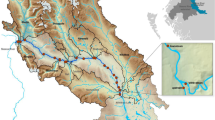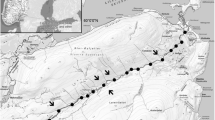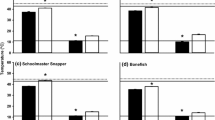Abstract
Temperature is important to fish in determining their geographic distribution. For cool- and cold-water fish, thermal regimes are especially critical at the southern end of a species’ range. Although temperature is an easy variable to measure, biological interpretation is difficult. Thus, how to determine what temperatures are meaningful to fish in the field is a challenge. Herein, we used the Connecticut River as a model system and Atlantic salmon (Salmo salar) as a model species with which to assess the effects of summer temperatures on the density of age 0 parr. Specifically, we asked: (1) What are the spatial and temporal temperature patterns in the Connecticut River during summer? (2) What metrics might detect effects of high temperatures? and (3) How is temperature variability related to density of Atlantic salmon during their first summer? Although the most southern site was the warmest, some northern sites were also warm, and some southern sites were moderately cool. This suggests localized, within basin variation in temperature. Daily and hourly means showed extreme values not apparent in the seasonal means. We observed significant relationships between age 0 parr density and days at potentially stressful, warm temperatures (≥23°C). Based on these results, we propose that useful field reference points need to incorporate the synergistic effect of other stressors that fish encounter in the field as well as the complexity associated with cycling temperatures and thermal refuges. Understanding the effects of temperature may aid conservation efforts for Atlantic salmon in the Connecticut River and other North Atlantic systems.







Similar content being viewed by others
References
Beitinger, T. L. & W. A. Bennett, 2000. Quantification of the role of acclimation temperature in temperature tolerance of fishes. Environmental Biology of Fishes 58: 277–288.
Beitinger, T. L., W. A. Bennett & R. W. McCauley, 2000. Temperature tolerances of North American freshwater fishes exposed to dynamic changes in temperature. Environmental Biology of Fishes 58: 237–275.
Blenckner, T., 2005. A conceptual model of climate-related effects on lake ecosystems. Hydrobiologia 533: 1–14.
Bowen, L., I. Werner & M. L. Johnson, 2006. Physiological and behavioral effects of zinc and temperature on coho salmon (Oncorhynchus kisutch). Hydrobiologia 559: 161–168.
Cairns, M. A., J. L. Ebersole, J. P. Baker, P. J. Wigington, H. R. Lavigne & S. M. Davis, 2005. Influence of summer stream temperatures on black spot infestation of juvenile coho salmon in the Oregon Coast Range. Transactions of the American Fisheries Society 134: 1471–1479.
Caissie, D., 2006. The thermal regime of rivers: a review. Freshwater Biology 51: 1389–1406.
Cameron, A. C. & F. A. Windemeijer, 1996. R-squared measures for count data regression models with applications to health-care utilization. Journal of Business and Economic Statistics 14: 209–219.
Campbell, C. A., 1999. Assessing large-scale patterns in the distribution, abundance, and size of juvenile Atlantic salmon in the Connecticut River. M.S. Thesis, University of Massachusetts, Amherst, MA.
Carle, F. L. & M. R. Strub, 1978. A new method for estimating population size from removal data. Biometrics 34: 621–630.
Connecticut River Atlantic Salmon Commission, 1998. Strategic plan for the restoration of Atlantic salmon to the Connecticut River (revised July 1, 1998). Sunderland, MA.
Crozier, L. & R. W. Zabel, 2006. Climate impacts at multiple scales: evidence for differential population responses in juvenile Chinook salmon. Journal of Animal Ecology 75: 1100–1109.
Cunjak, R. A., D. Caissie, N. El-Jabi, P. Hardie, J. H. Conlon, T. L Pollock, D. J. Giberson & S. Komadina-Douthwright, 1993. The Catamaran Brook (New Brunswick) habitat research project: biological, physical, and chemical conditions (1990–1992). Canadian Technical Report of Fisheries and Aquatic Sciences No. 1914.
Currie, R. J., W. A. Bennett, T. L. Beitinger & D. S. Cherry, 2004. Upper and lower temperature tolerances of juvenile freshwater game-fish species exposed to 32 days of cycling temperatures. Hydrobiologia 523: 127–136.
Davis, M. W., B. L. Olla & C. B. Schreck, 2001. Stress induced by hooking, net towing, elevated sea water temperature and air in sablefish: lack of concordance between mortality and physiological measures of stress. Journal of Fish Biology 58: 1–15.
Dunham, J., R. Schroeter & B. Rieman, 2003. Influence of maximum water temperature on occurrence of Lahontan cutthroat trout within streams. North American Journal of Fisheries Management 23: 1042–1049.
Dynesius, M. & C. Nilsson, 1994. Fragmentation and flow regulation of river systems in the northern 3rd of the world. Science 266: 753–762.
Eaton, J. G., J. H. McCormick, B. E. Goodno, D. G. O’Brien, H. G. Stefany, M. Hondzo & R. M. Scheller, 1995. A field information-based system for estimating fish temperature tolerances. Fisheries 20(4): 10–18.
Eaton, J. G. & R. M. Scheller, 1996. Effects of climate warming on fish thermal habitat in streams of the United States. Limnology and Oceanography 41: 1109–1115.
Elliott, J. M., 1991. Tolerance and resistance to thermal stress in juvenile Atlantic salmon. Freshwater Biology 25: 61–70.
Elliott, J. M. & J. A. Elliott, 1995. The effect of the rate of temperature increase on the critical thermal maximum for parr of Atlantic salmon and brown trout. Journal of Fish Biology 47: 917–919.
Elliott, J. M. & M. A. Hurley, 1997. A functional model for maximum growth of Atlantic salmon par (Salmo salar), from two populations in northwest England. Functional Ecology 11: 592–603.
Flebbe, P. A., L. D. Roghair & J. L. Bruggink, 2006. Spatial modeling to project southern Appalachian trout distribution in a warmer climate. Transactions of the American Fisheries Society 135: 1371–1382.
Forseth, T., M. A. Hurley, A. J. Jensen & J. M. Elliott, 2001. Functional models for growth and food consumption of Atlantic salmon parr, Salmo salar, from a Norwegian River. Freshwater Biology 46: 173–186.
Franco, E. A. D. & P. Budy, 2005. Effects of biotic and abiotic factors on the distribution of trout and salmon along a longitudinal stream gradient. Environmental Biology of Fishes 72: 379–391.
Fry, F. E. J., 1967. Responses of vertebrate poikilotherms to temperature. In Rose, A. H. (ed.), Thermobiology. Academic Press, New York, NY: 375–409.
Galbreath, P. F., N. D. Adams & T. H. Martin, 2004. Influence of heating rate on measurement of time to thermal maximum in trout. Aquaculture 241: 587–599.
Gardner, B., P. J. Sullivan & A. J. Lembo, 2003. Predicting stream temperatures: geostatistical model comparison using alternative distance metrics. Canadian Journal of Fisheries and Aquatic Sciences 60: 344–351.
Garside, E. T., 1973. Ultimate upper lethal temperature of Atlantic salmon, Salmo salar. Canadian Journal of Zoology 51: 898–900.
Gooseff, M. N., K. Strzepek & S. C. Chapra, 2005. Modeling the potential effects of climate change on water temperature downstream of a shallow reservoir, Lower Madison River, MT. Climatic Change 68: 331–353.
Grande, M. & S. Andersen, 1991. Critical thermal maxima for young salmonids. Journal of Freshwater Ecology 6: 275–279.
Habit, E., M. C. Belk & O. Parra, 2007. Response of the riverine fish community to the construction and operation of a diversion hydropower plant in central Chile. Aquatic Conservation-Marine and Freshwater Ecosystems 17: 37–49.
Heath, S. T., W. A. Bennett, J. Kennedy & T. L. Beitinger, 1994. Heat and cold tolerance of the fathead minnow, Pimephales promelas, exposed to the synthetic pyrethroid cyfluthrin. Canadian Journal of Fisheries and Aquatic Sciences 51: 437–440.
Huntsman, A. G., 1942. Death of salmon and trout with high temperature. Journal of the Fisheries Research Board of Canada 5: 485–501.
Isaak, D. J. & W. A. Hubert, 2004. Nonlinear response of trout abundance to summer stream temperatures across a thermally diverse montane landscape. Transactions of the American Fisheries Society 133: 1254–1259.
Johnson, S. L., 2004. Factors influencing stream temperatures in small streams: substrate effects and a shading experiment. Canadian Journal of Fisheries and Aquatic Sciences 61: 913–923.
Johnstone, H. C. & F. J. Rahel, 2003. Assessing temperature tolerance of Bonneville cutthroat trout based on constant and cycling thermal regimes. Transactions of the American Fisheries Society 132: 92–99.
Jonsson, B., T. Forseth, A. J. Jensen & T. J. Naesje, 2001. Thermal performance of juvenile Atlantic salmon, Salmo salar L. Functional Ecology 15: 701–711.
Kangur, A., P. Kangur, K. Kangur & T. Mols, 2007. The role of temperature in the population dynamics of smelt Osmerus eperlanus eperlanus m. spirinchus Pallas in Lake Peipsi (Estonia/Russia). Hydrobiologia 584: 433–441.
Keleher, C. J. & F. J. Rahel, 1996. Thermal limits to salmonid distributions in the Rocky Mountain region and potential habitat loss due to global warming: a Geographic Information System (GIS) approach. Transactions of the American Fisheries 125: 1–13.
Kishi, D., M. Murakami, S. Nakano & Y. Taniguchi, 2004. Effects of forestry on the thermal habitat of Dolly varden (Salvelinus malma). Ecological Research 19: 283–290.
Lobón-Cerviá, J. & E. Mortensen, 2005. Population size in stream-living juveniles of lake-migratory brown trout Salmo trutta L.: the importance of stream discharge and temperature. Ecology of Freshwater Fishes 14: 394–401.
Lund, S. G., D. Caissie, R. A. Cunjak, M. M. Vijayan & B. L. Tufts, 2002. The effects of environmental heat shock mRNA and protein expression in Miramichi Atlantic salmon (Salmo salar) parr. Canadian Journal of Fisheries and Aquatic Sciences 59: 1553–1562.
McMenemy, J. R., 1995. Survival of Atlantic salmon fry stocked at low density in the West River, Vermont. North American Journal of Fisheries Management 15: 366–374.
Meeuwig, M. H., J. B. Dunham, J. P. Hayes & G. L. Vinyard, 2004. Effects of constant and cyclical thermal regimes on growth and feeding of juvenile cutthroat trout of variable sizes. Ecology of Freshwater Fish 13: 208–216.
Meisner, J. D., 1990. Effect of climatic warming on the southern margins of the native range of brook trout, Salvelinus fontinalis. Canadian Journal of Fisheries and Aquatic Sciences 47: 1065–1070.
Mesa, M. G., 1994. Effects of multiple acute stressors on the predator avoidance ability and physiology of juvenile Chinook salmon. Transactions of the American Fisheries Society 123: 786–793.
Meyer, J. S., D. D. Gulley, M. S. Goodrich, D. C. Szmania & A. S. Brooks, 1995. Modeling toxicity due to intermittent exposure of rainbow trout and common shiners to monochloramine. Environmental Toxicology and Chemistry 14: 165–175.
Meyers, T. F., 1994. The program to restore Atlantic salmon to the Connecticut River. In Calabi, S. & A. Stout (eds), A Hard Look at Some Tough Issues. New England Atlantic Salmon Management Conference, New England Salmon Commission, Newburyport, MA: 11–21.
Moffitt, C. M., B. Kynard & S. G. Rideout, 1982. Fish passage facilities and anadromous fish restoration in the Connecticut River basin. Fisheries 7(6): 2–11.
Morgan, I. J., D. G. McDonald & C. M. Wood, 2001. The cost of living for freshwater fish in a warmer, more polluted world. Global Change Biology 7: 345–355.
Myers, R. H., 1990, Classical and Modern Regression with Applications. Duxbury Press, Pacific Grove, CA.
Nelitz, M. A., E. MacIssac, R. Peterman, 2007. A science based approach for identifying temperature sensitive streams for rainbow trout. North American Journal of Fisheries Management 27: 405–424.
Parrish, D. L., R. J. Benke, S. G. Gephard, S. McCormick & G. H. Reeves, 1998. Why aren’t there more Atlantic salmon (Salmo salar)? Canadian Journal of Fisheries and Aquatic Sciences 55(Supplement 1): 281–287.
Perry, A. L., P. J. Low, J. R. Ellis & J. D. Reynolds, 2005. Climate change and distribution shifts in marine fishes. Science 308: 1912–1915.
Poff, L., J. D. Allan, M. B. Bain, J. R. Karr, K. L. Prestegaard, B. Richter, R. Sparks & J. Stromberg, 1997. The natural flow regime: a new paradigm for riverine conservation and restoration. BioScience 47: 769–784.
Poole, G. C. & C. H. Berman, 2004. An ecological perspective on in-stream temperature: natural heat dynamics and mechanisms of human-caused thermal degradation. Environmental Management 27: 787–802.
Pörtner, H. O. & R. Knust, 2007. Climate change affects marine fishes through the oxygen limitation of thermal tolerance. Science 315: 95–97.
Preston, B. L., 2006. Risk-based reanalysis of the effects of climate change on US cold-water habitat. Climatic Change 76: 91–119.
Quinn, G. P. & M. J. Keough, 2002. Experimental Design and Data Analysis for Biologists. Cambridge University Press, Cambridge, UK.
Raffenberg, M. J. & D. L. Parrish, 2003. Atlantic salmon and trout: interactions of species at large scales. Canadian Journal of Fisheries and Aquatic Sciences 60: 279–285.
SAS Institute, 2003. SAS 9.1. Cary, North Carolina.
Schindler, D. W., 2001. The cumulative effects of climate warming and other human stresses on Canadian freshwaters in the new millennium. Canadian Journal of Fisheries And Aquatic Sciences 58: 18–29.
Schmidt-Nielsen, J., 1990. Animal Physiology: Adaptation and Environment. Cambridge University Press, Cambridge, England.
Schrank, A. J., F. J. Rahel & H. C. Johnstone, 2003. Evaluating laboratory-derived thermal criteria in the field: an example involving Bonneville cutthroat trout. Transactions of the American Fisheries Society 132: 100–109.
Stoneman, C. L. & M. L. Jones, 2000. The influence of habitat features on the biomass and distribution of three species of southern Ontario stream salmonines. Transactions of the American Fisheries Society 129: 639–657.
Union of Concerned Scientists (UCS), 2006. Climate Change in the U.S. Northeast UCS Publications, Cambridge, MA.
Wang, L. Z., J. Lyons & P. Kanehl, 2003. Impacts of urban land cover on trout streams in Wisconsin and Minnesota. Transactions of the American Fisheries Society 132: 825–839.
Watenpaugh, D. E., T. L. Beitinger & D. W. Huey, 1985. Temperature tolerance of nitrite-exposed channel catfish. Transactions of the American Fisheries Society 114: 274–278.
Wehrly, K. E., L. Wang & M. Mitro, 2007. Field based estimates of thermal tolerance limits for trout incorporating exposure time and temperature fluctuations. Transactions of the American Fisheries Society 136: 365–374.
Welsh, H. H., F. R. Hodgson, B. C. Harvey & M. F. Roche, 2001. Distribution of juvenile coho salmon in relation to water temperatures in tributaries of the Mattole River, California. North American Journal of Fisheries Management 21: 464–470.
Wheeler, A. P., P. L. Angermeier & A. E. Rosenberger, 2005. Impacts of new highways and subsequent landscape urbanization on stream habitat and biota. Reviews in Fisheries Science 13: 141–164.
Acknowledgments
We thank Mike Briggs for help with data analysis. This project was funded by the U.S. Forest Service, Northeastern Research Station, Amherst, MA and the U.S. Geological Survey, Northern Appalachian Research Laboratory, and administered through the Massachusetts Cooperative Fish and Wildlife Research Unit and Department of Natural Resources Conservation at the University of Massachusetts, Amherst. The Massachusetts Cooperative Fish and Wildlife Research Unit is a cooperation among the University of Massachusetts, the U.S. Geological Survey, the Massachusetts Division of Marine Fisheries, the Massachusetts Division of Fisheries and Wildlife, and the Wildlife Management Institute. The Vermont Cooperative Fish and Wildlife Research Unit is jointly supported by the U.S. Geological Survey, Vermont Department of Fish and Wildlife, the University of Vermont, and the Wildlife Management Institute. Use of brand names does not confer endorsement by the U.S. federal government. Ryan Butryn and two anonymous reviewers improved the manuscript.
Author information
Authors and Affiliations
Corresponding author
Additional information
Handling editor: T. P. Crowe
Rights and permissions
About this article
Cite this article
Mather, M.E., Parrish, D.L., Campbell, C.A. et al. Summer temperature variation and implications for juvenile Atlantic salmon. Hydrobiologia 603, 183–196 (2008). https://doi.org/10.1007/s10750-007-9271-2
Received:
Revised:
Accepted:
Published:
Issue Date:
DOI: https://doi.org/10.1007/s10750-007-9271-2




